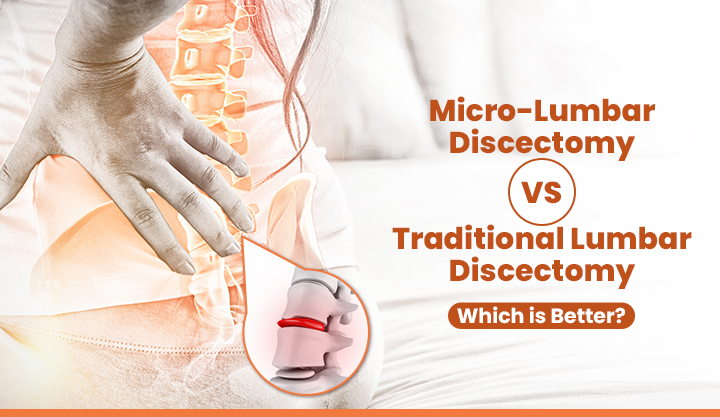
Micro-Lumbar Discectomy vs. Traditional Lumbar Discectomy: Which is Better?
Back pain is a common health issue that can strike anyone, young or old. One of the most common culprits behind back pain is a herniated disc in the lumbar spine. When this happens, the disc puts pressure on the nerves in your back, causing severe pain and discomfort. Unfortunately, this condition often affects people in the prime of their lives, between the ages of 30 and 50.
Fortunately, there are ways to treat a herniated disc. Typically, doctors recommend a combination of medication, rest, exercise, and physiotherapy to alleviate the pain and help the disc heal. However, in some cases, these treatments are insufficient, and the pain persists for weeks or even months. That’s when your doctor may suggest lumbar discectomy surgery.
Traditional lumbar discectomy has been the go-to option for this procedure for years. But as technology has advanced, so too have the surgical options available. Enter micro-lumbar discectomy, a less invasive alternative that promises many benefits. Let’s look at the differences between the two procedures and explore which one may be right for you.
Traditional Lumbar Discectomy
Traditional lumbar discectomy is an open surgical procedure involving a large incision in the back to access the herniated disc. The surgeon removes the damaged part of the disc and any other tissue that may be compressing the nerve root. This procedure usually requires a hospital stay of several days and a more extended recovery period than the micro-lumbar discectomy.
Micro-Lumbar Discectomy- A Minimally Invasive Surgery
Micro-lumbar discectomy is a minimally invasive surgical procedure involving a small incision in the back. The surgeon uses a microscope to visualize the herniated disc and removes the damaged part of the disc through the small incision. This procedure usually requires only a short hospital stay and a shorter recovery period than the traditional discectomy. Micro-lumbar discectomy is also associated with less blood loss, tissue damage, and a lower risk of infection.
A Head-to-Head Comparison of Traditional and Micro-Lumbar Surgery
Incision Size
Traditional discectomy requires a larger incision compared to micro-lumbar discectomy. The size of the incision for a traditional discectomy typically ranges from 2-5 inches. In contrast, micro lumbar discectomy is a minimally invasive surgery in which the incision is usually less than an inch. A smaller incision means less tissue damage and scarring and may result in less post-operative pain and faster healing.
Anesthesia
Traditional lumbar discectomy requires general anesthesia, which puts the patient to sleep during the surgery. In contrast, micro-lumbar discectomy can be performed under local anesthesia or light sedation, which means the patient is awake but relaxed during the procedure. Local anesthesia or light sedation carries fewer risks than general anesthesia and may result in a faster recovery time.
Hospital Stay
Patients undergoing traditional lumbar discectomy usually require a longer hospital stay than those undergoing micro-lumbar discectomy. With traditional lumbar discectomy, patients typically stay in the hospital for 1-2 days. In contrast, with micro-lumbar discectomy, patients can often go home on the same day. A shorter hospital stay may lead to lower healthcare costs and a quicker return to normal activities.
Recovery Time
Patients undergoing micro-lumbar discectomy generally have a faster recovery time than traditional lumbar discectomy. Recovery time for traditional lumbar discectomy can range from 4-12 weeks, while recovery time for micro-lumbar discectomy is typically 2-4 weeks. This means that patients who undergo micro-lumbar discectomy may be able to return to work or other activities sooner, resulting in less lost income and a faster return to normal daily routines.
Pain Relief
Both traditional lumbar discectomy and micro-lumbar discectomy are effective at providing pain relief for patients with herniated discs. However, a micro-lumbar discectomy may result in less post-operative pain compared to a traditional lumbar discectomy due to the smaller incision size and less tissue damage. In addition, because micro-lumbar discectomy is less invasive, patients may require less pain medication during the recovery period.
Cost
The cost of lumbar discectomy can vary depending on several factors, such as the hospital or clinic where the procedure is performed, the extent of the surgery, and the patient’s insurance coverage. Generally speaking, micro-lumbar discectomy tends to be more expensive than traditional lumbar discectomy due to the specialized equipment and techniques used.
Both traditional lumbar discectomy and micro-lumbar discectomy are effective at treating herniated discs in the lower back. However, micro-lumbar discectomy offers several advantages over traditional lumbar discectomy.
If you are considering lumbar discectomy surgery, be sure to discuss your options with your doctor to determine which procedure is best for your individual needs.
If you are facing chronic back pain, book an appointment with our experts at https://pp.yashodahospital.org/
